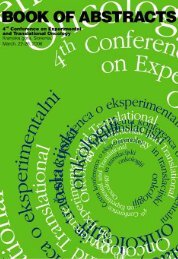Create successful ePaper yourself
Turn your PDF publications into a flip-book with our unique Google optimized e-Paper software.
Development <strong>of</strong> three-dimensional (3D) all-human, in vitro models for<br />
study <strong>of</strong> the biology <strong>of</strong> primary and metastatic brain tumours<br />
S. A. Murray, K. Fry, G. J. Pilkington<br />
Cellular & Molecular Neuro-oncology Group, Institute <strong>of</strong> Biomedical & Biomolecular Sciences, School<br />
<strong>of</strong> Pharmacy & Biomedical Sciences, University <strong>of</strong> Portsmouth, St Michael’s Building, White Swan Road,<br />
Portsmouth PO1 2DT UK<br />
Animal models for the study <strong>of</strong> local invasive behaviour and metastasis <strong>of</strong> brain tumour<br />
poorly reflect the situation in human counterpart neoplasms. Moreover, 3D in vitro<br />
invasion models for invasion generally utilise non-human (rat/mouse) glioma cells and/<br />
or rat brain/chick heart fragments as a “target” for invasion. Similarly, in vitro models<br />
<strong>of</strong> the B-BB generally utilise porcine or murine brain endothelium and rat astrocytes. In<br />
addition, these models are grown in foetal calf serum supplemented conditions which<br />
modify growth rates and cell adhesive properties. Our aims were, therefore, to develop 3D<br />
in vitro models from human brain-derived cells for the study <strong>of</strong>: a) brain cell:glioma cell<br />
interaction and invasive behaviour and b) passage <strong>of</strong> metastatic somatic cancer cells across<br />
the cellular blood-brain barrier (B-BB).<br />
For the invasion model we have used human glioma biopsy-derived cells and temporal<br />
lobe epilepsy resection (TLER) brain maintained as spheroids through an adaptation<br />
<strong>of</strong> the hanging drop method and juxtaposed in 3D confrontation culture under human<br />
serum (HS) supplementation. For the B-BB model we have used astrocyte-rich human<br />
cultures from TELR brain in combination with human cerebral microvascular endothelial<br />
cells (CMECs) immortalised with hTERT/SV40LargeT, under HS supplementation. All<br />
cells have been characterised with appropriate immuno markers using flow cytometry<br />
and immunocytochemistry while growth curves and adhesion properties have been<br />
established.<br />
Growth curves, spheroid growth rates, scanning electron microscopy, confocal microscopy,<br />
antigenic expression, adhesive properties and growth on Transwells have been established<br />
for each model and for the individual component cells.<br />
We are currently<br />
l38<br />
assessing the models using a combination <strong>of</strong> live cell imaging, WetSEM,<br />
TIRF microscopy and confocal microscopy in studies where putative inhibitors <strong>of</strong><br />
invasion/metastasis are under investigation.<br />
This research is supported by grant funding from the Dr Hadwen Trust (www.drhadwentrust.co.uk) and<br />
the Lord Dowding Fund and a PhD bursary from the Institute <strong>of</strong> Biomedical & Biomolecular Sciences,<br />
University <strong>of</strong> Portsmouth.<br />
54
















